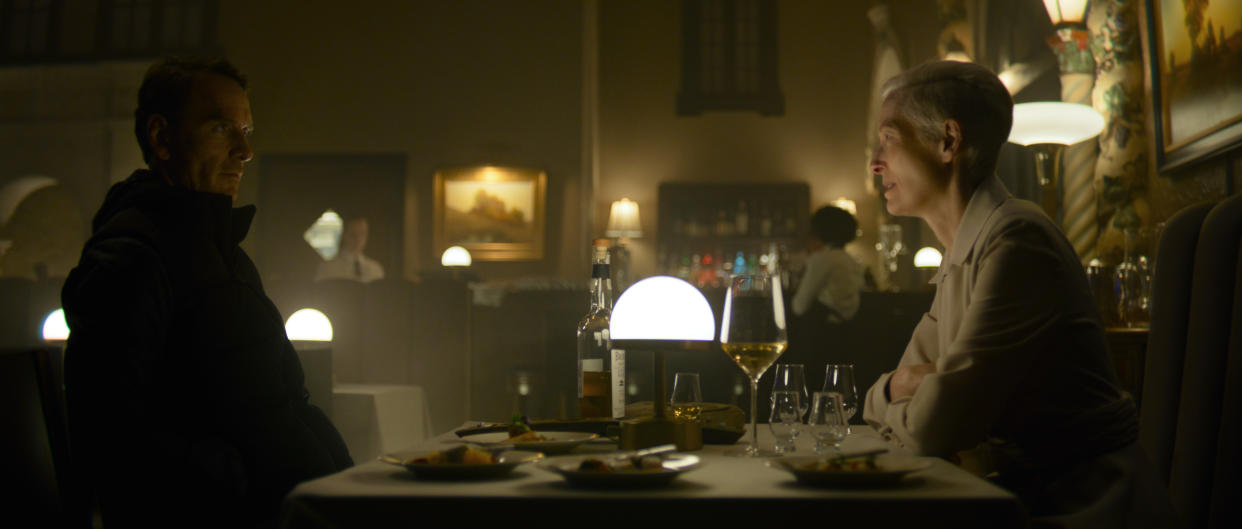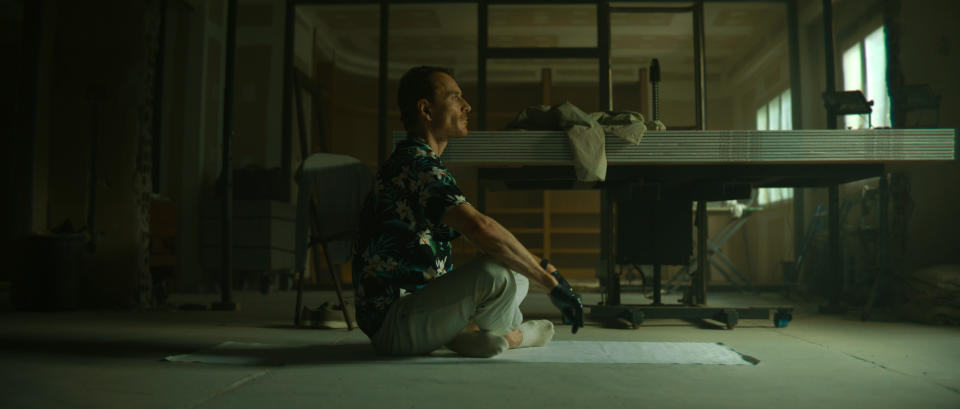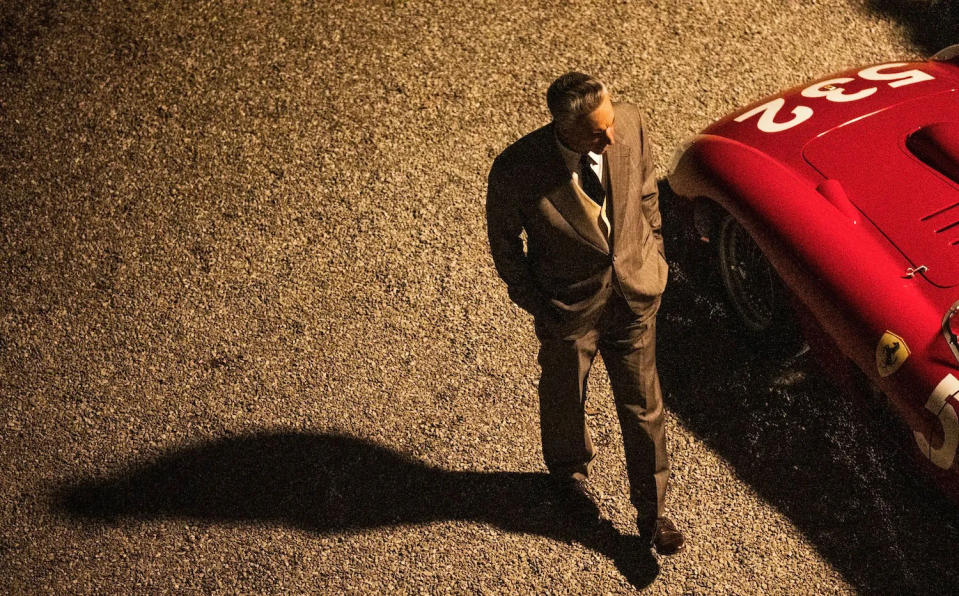Two of 2023’s Most Strikingly Filmed Movies Are from the Same Cinematographer

- Oops!Something went wrong.Please try again later.
- Oops!Something went wrong.Please try again later.
David Fincher‘s “The Killer” and Michael Mann‘s “Ferrari” are two of the most visually sophisticated films of the fall season, though their approaches are as different as those two directors’ sensibilities. “The Killer” is icy and deglamorized where “Ferrari” is smoking hot and visceral; Fincher puts his character under a microscope for the audience to study like a microbe, while Mann wants the audience in the driver’s seat with his passionate and committed characters. What the two films have in common is an attention to light, color, and framing as expressive tools that is exceptional in its precision; few movies in recent memory have guided the viewer’s eye in such an intentional and affecting manner. That’s because of something else these movies share: cinematographer Erik Messerschmidt.
Just seven years ago, Messerschmidt was a respected gaffer on series like “Mad Men” and “Bones.” That changed when, on the set of “Gone Girl,” Fincher recognized Messerschmidt’s taste and talent; he promoted the gaffer to director of photography on his Netflix series “Mindhunter,” which led to Messerschmidt’s collaboration with Fincher on “Mank.” Messerschmidt’s shimmering black-and-white photography on that movie earned him some well-deserved attention — and an Academy Award for his first cinematography credit on a feature film.
More from IndieWire
Unsurprisingly, Fincher returned to Messerschmidt when the time came to make “The Killer,” though the director of photography says the initial conversations were quite different. “It was unique because we didn’t really talk about the way the movie was meant to look at all,” Messerschmidt told IndieWire. “We talked about pace and structure and how he wanted to handle the voiceover and structure the scenes. We talked about the movie much more abstractly than when we were talking about ‘Mank.’ The palette and aesthetic came much later in the process.”

That aesthetic was largely driven by the title character played by Michael Fassbender, whose point of view is conveyed elegantly by Messerschmidt and Fincher’s use of lenses and camera position; throughout the film, they alternate between extremely subjective depictions of the assassin’s perspective and more distanced, objective frames designed to give the audience time for reflection and analysis. “The movie is very much a conversation about subjectivity and objectivity,” Messerschmidt said. “We were very concerned about when we’re inside his head and looking at what he’s looking at, and when are we observing him. This is a character who never allows anyone into his inner space, he’s always alone and he’s completely unaware of the camera.”
Keeping that in mind, Messerschmidt and Fincher adopted visual strategies to move in and out of the killer’s point of view. “When he’s in control, the camera is slightly closer than it normally would be, it’s not a fly on the wall,” Messerschmidt said. “It’s a fly hovering just a little bit too close.” Messerschmidt described the structure of the film as a “call and response” between a point of view and a more objective camera and noted the intersection between cinematography and editing that helped generate Fincher’s desired effects. “The photography has to support the editing and the structure of the scene. If a scene requires rapid pacing and you want the opportunity to accelerate action, you know you need coverage. If it’s a tranquil moment or quiet pause in the film it can be done in one shot.”
Messerschmidt added that cinematography not only works in conjunction with editing, it is editing in a sense. “We’re excluding certain things from the frame, making decisions about how many shots we need,” he said. For one of the movie’s key set pieces, a fight between the killer and a character known as “The Brute,” Messerschmidt was meticulous about laying out the geography of the space for the audience. “In traditional fight choreography, you often deliberately disorient the audience to make things feel frenetic, but that was not at all what we wanted to do. We wanted to be quite dogmatic with screen direction so that the audience would understand the layout of the house.”
That rigor led to one of the best action sequences not only of the year, but in Fincher’s entire oeuvre, and it’s largely because it’s one of the best examples of the film’s use of visual space to connect the character and the audience. “We had had a conversation early on that we wanted the audience subconsciously to come to the same conclusion as the killer: that he needs to get back where he dropped the gun because he’s horribly outmatched throughout the scene,” Messerschmidt said. “We thought it’d be interesting if the audience almost said, ‘Hey, the gun’s under the bed, you’re back where you started.’ I think the audience is so educated in cinema grammar now that when you use screen direction well and when the scene cuts elegantly the way this one does, they really build a 3D map in their head of where they are, even if they’re not doing it on purpose.”
Where “The Killer” presented an ongoing dialogue between objectivity and subjectivity, “Ferrari” alternates between two distinct takes, one assigned to the more dialogue-driven scenes and one for the highly kinetic racing sequences. “There are really almost two separate films,” Messerschmidt said. “There’s the performance portion of the film, which we shot first, and then there’s the racing. Michael wanted to treat those as two very separate experiences for the audience.” Those performance scenes feature some of Messerschmidt’s most gorgeous lighting to date, as he emulates the light of Italian painters like Tintoretto and Caravaggio; one could take many of the frames from “Ferrari” out of the movie and hang them on the wall.

Yet according to Messerschmidt, his goal is less about beauty than simply serving the story. “You never want the aesthetic of a movie to get in front of the performance,” he said, adding that he was under a lot of self-imposed pressure to live up to Mann’s expectations. “‘Ferrari’ is a film that Michael has been planning for 30 years — he’s been prepping and researching it since before I had a driver’s license. So I felt an enormous responsibility to deliver for him.” As in the case of “The Killer,” that meant being extremely disciplined about every aspect of the visual style, with particular attention in “Ferrari” paid to the palette. “We wanted to make sure that the only time you saw red in the film was in the cars. The rest of the movie has these muted greens and yellows and a little bit of cold blue, so when you see the car for the first time there’s a very distinct, vibrant tone.”
“Ferrari” is at its most effective in sequences that join the two sides of the narrative together, as when Mann cuts between a leisurely church service and a frenzied race. “The guiding principle was to contrast what a horrifically dangerous exercise racing in the 1950s was with this aristocratic, very regal Northern Italian family that is restrained and traditional,” Messerschmidt said. “That scene in the church is a perfect example of one movie that’s very elegant and classical set against another with a very aggressive, shaky camera.” The dynamism of the racing set pieces is due largely to the fact that Mann didn’t want to rely on green screen or any tricks of editing or lenses to make the cars seem like they were going faster than they were. “We were driving the cars on real roads and real tracks at high speed. Michael was not interested in shooting the cars at 50 miles an hour.”
Looking back on the two films, Messerschmidt remarked that they had something in common in addition to their directors’ dedication and tenacity. “On both movies, I was really struck by the collaboration between the actors and the camera department,” he said. “So often we’re sort of chasing the actor, but these were very much a case of collaboration between performance and technology. Michael on ‘The Killer’ and Penelope [Cruz] and Adam [Driver] on ‘Ferrari’ were very aware of where the camera was and of how we were shooting their scenes and did whatever they could to support what we were trying to do. That mutual respect is kind of rare these days, and I hope it continues in my life because it was really nice.”
Best of IndieWire
Quentin Tarantino's Favorite Movies: 60 Films the Director Wants You to See
Where to Watch This Week's New Movies, Including 'The Iron Claw' and 'All of Us Strangers'
2023 Movies Shot on Film: From 'Oppenheimer' to 'Killers of the Flower Moon' and 'Maestro'
Sign up for Indiewire's Newsletter. For the latest news, follow us on Facebook, Twitter, and Instagram.

